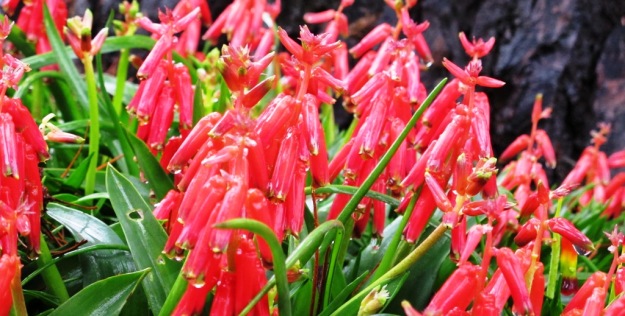
Left to right: Lachenalia aloides quadricolor, bulbifera, reflexa hybrid, aloides
Pity the early-blooming lachenalias for none of them are blue. And the blues and mauves are the sought after members of this plant family. But as winter draws to a close, it is the cheerful red, orange and yellow combinations that light up a grey day. It is all in how you use them.

Nothing subtle about aloides but great in semi-wild areas
I had not been a fan of the most common form of Lachenalia aloides. It lacks refinement and reminds me of cheap, fake flowers. But when I relocated surplus bulbs out to an open area near our entrance, I changed my mind. They are a bright splash of colour around an old tree trunk which makes me smile. The addition of the undervalued muscari (grape hyacinths) that remind me of my childhood adds a splash of pure blue, making the colour seem even brighter, along with an early flowering scilla. We have a particularly strong growing form in New Zealand which you can still occasionally find under its completely incorrect name of Lachenalia ‘Pearsonii’. It is just a strong-growing, tall strain of aloides with its distinctive orange and red colouring.

Same species, aloides. Quadricolor to the right.
L. aloides is a variable species and one of our early bloomers is another form – L. aloides quadricolor. It has a little more subtlety than its more vibrant, stronger sibling. The individual flowers are little smaller and finer, although still on a strong stem. Quadricolour refers to the four colours – red, yellow, green and interesting maroon or burgundy tips. There is a complexity to these flowers which counters the somewhat garish effect that can be evident in the more common form.
L. aloides tricolor flowers later for us and is smaller in size and basically green with red tips. The most desirable of this set is probably L. aloides var. vanzyliae but it is the one we are struggling to get growing well. I will keep an eye out for flowers as the season progresses because it is an unusual white with pale blue at the base and bright green tips and it is just as lovely as it sounds. When I find it again – and I have it in about three places – I will lift the bulbs because I think this one will be best kept to a pot.

Lachenalia bulbifera
Red L. bulbifera is the first of the season to come into flower for us. It is easy to grow and sets a multitude of little bulbs, though not to the extent that we have classified it as invasive or dangerous. It is another one that I like planted around the trunk of an old tree giving a bright spot of colour in the distance and drawing one over for a closer look.

Mark’s reflexa hybrid is stronger growing than the straight species
The yellow is Mark’s L. reflexa hybrid. Because we struggle with the dreaded narcissi fly, he was casting round for alternative yellows to daffodils for naturalising. While not quite a pure yellow (the tips can have a red tinge), it is a strong and reliable grower and gives the yellow carpet effect though we have yet to get a major drift established in grass conditions.
Lachenalias are South African bulbs, mostly from the Cape Province. Some are very easy to grow, others less so. Naturally the very choice varieties are the ones that are less amenable but that is always the way. Some are desert plants and we struggle with those, but the ones that grow in areas of winter rainfall are generally easy and reliable in our conditions. A few, like L. glaucina, are particularly frost tender. Lachenalias last very well as a cut flower and will out-bloom most other late winter and spring bulbs in the garden. L. bulbifera is already in bloom by the beginning of July while the white L. contaminata flowers through November. A family of easy-care bulbs which gives us a full five months of blooming across the colour spectrum – what is not to like?








I am a new sign up to your mail list , I have been receiving the email for about 2 months now , & I just wanted to let you know how awesome they are ,I have learned so much already.
I have been driving past a house close to me that is bursting with these Lachenalia’s , but I never new what they where called , then I got this email :)
, keep up the good work.
So glad you are enjoying it Luke and thank you for taking the time to tell me.
Well Abbie most interesting about Lachenalias.I think they are wonderfull bright colour especially as they flower in the winter.I planted a lot at the city Admin bldg. Manukau City in the 1970’s and even men commented how the bright flowers certainly brightened up the place on horrible cold dull winter days.Hurrah for Lachenalias I say.I sent you the photos recently.Thank JohnStrickett.I have daffodils ,jonquils ,and crocus in planters in flower which bring joy on winter days too
Pingback: An abundance of spring bloom | Tikorangi The Jury Garden